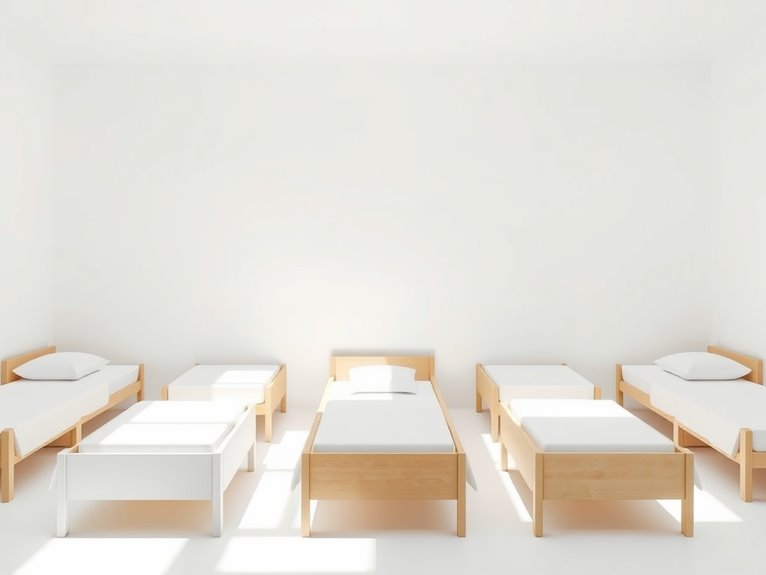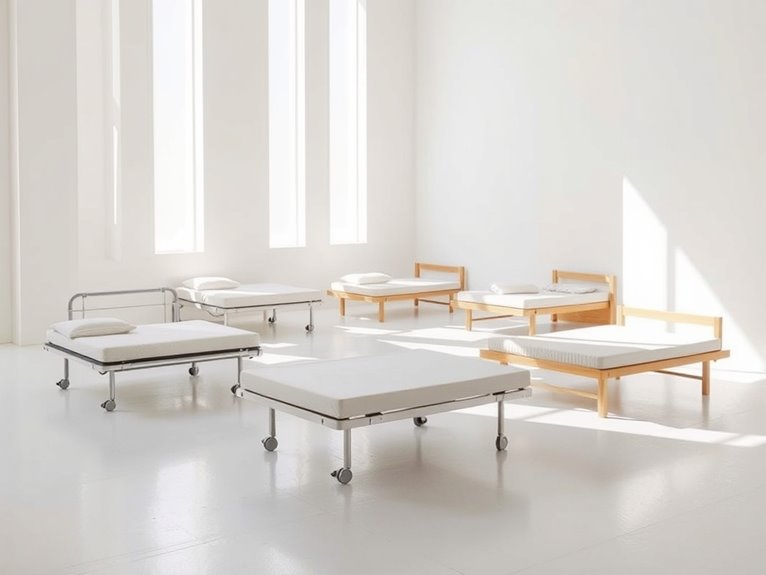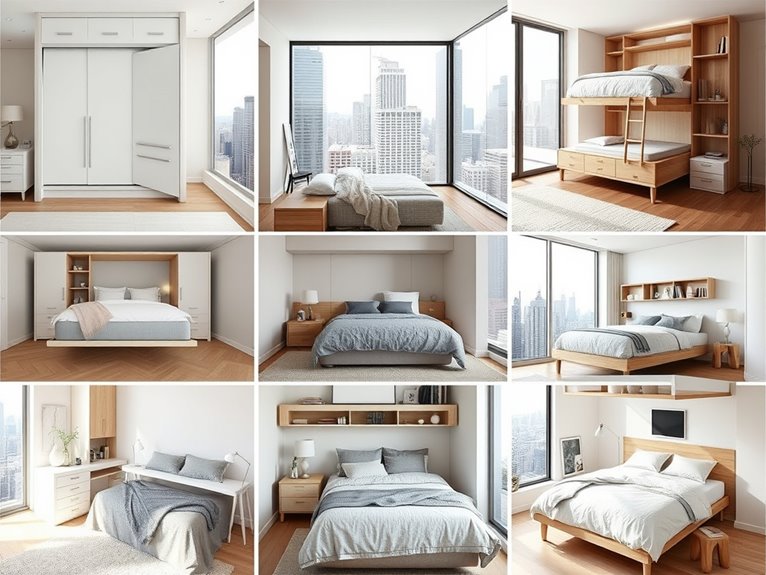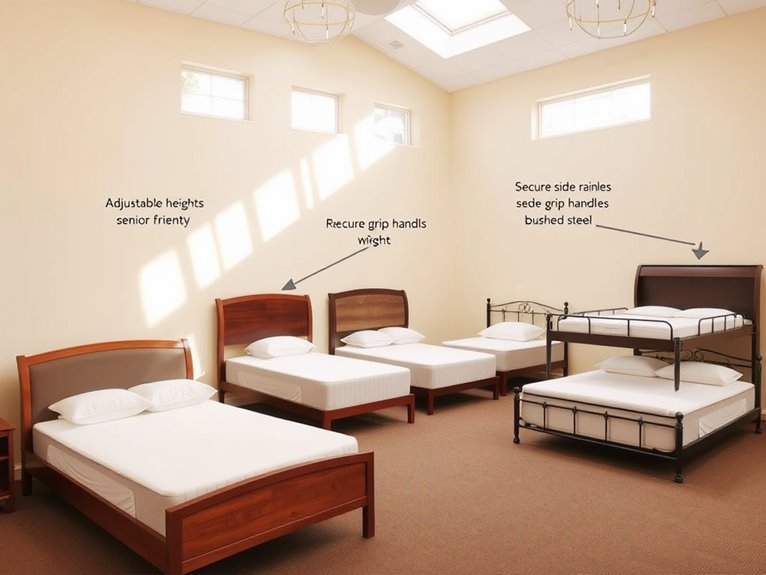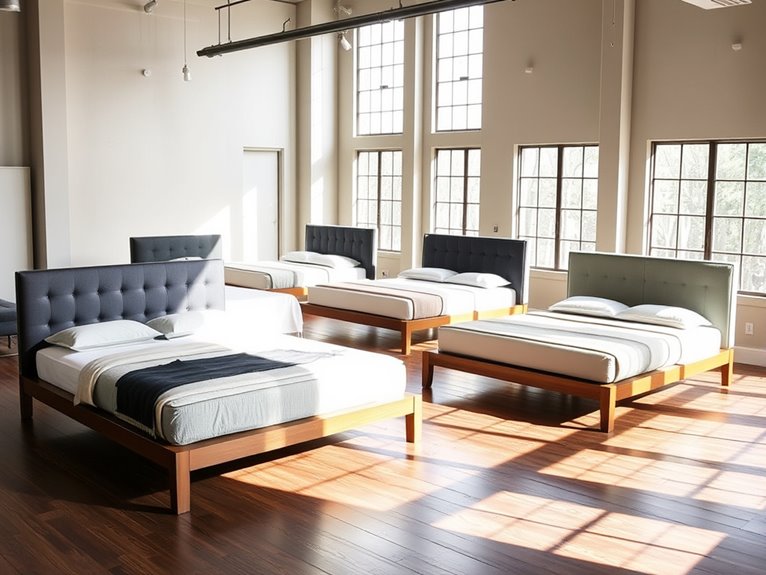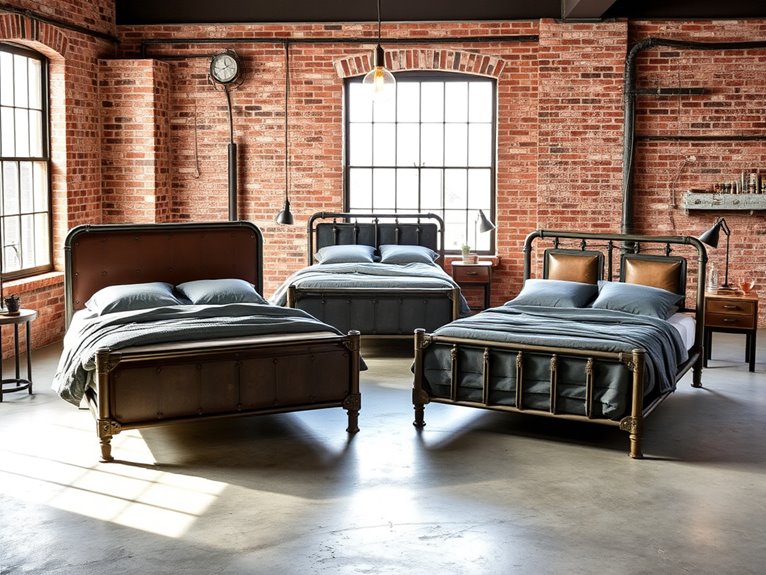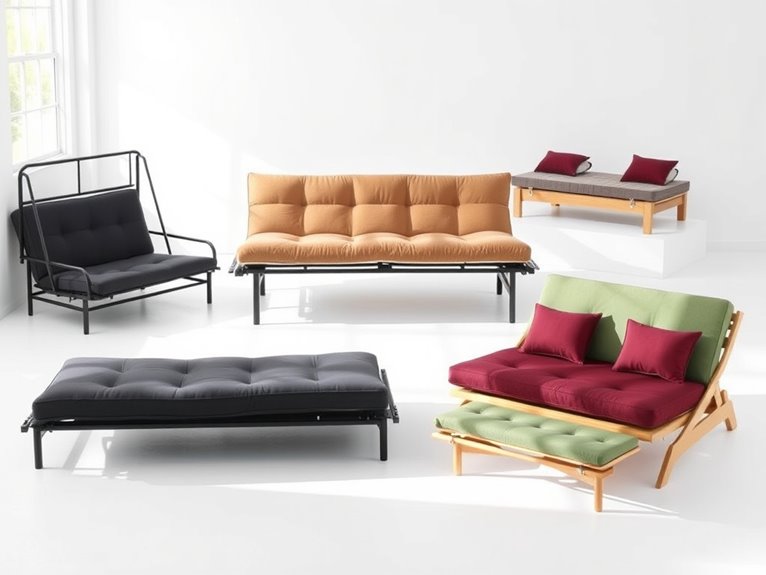8 Minimalist Kids’ Beds
Studies show that 68% of parents prioritize functional design when choosing children’s furniture. If you’re searching for a bed that combines style with practicality, minimalist designs offer the perfect solution for your child’s space. From sleek platform frames to imaginative house-shaped structures, these eight carefully curated options showcase how simple aesthetics can create calming spaces that grow with your little one. Let’s explore these thoughtfully designed beds that’ll transform your child’s room into a serene sanctuary.
Simple Platform Bed With Clean Lines
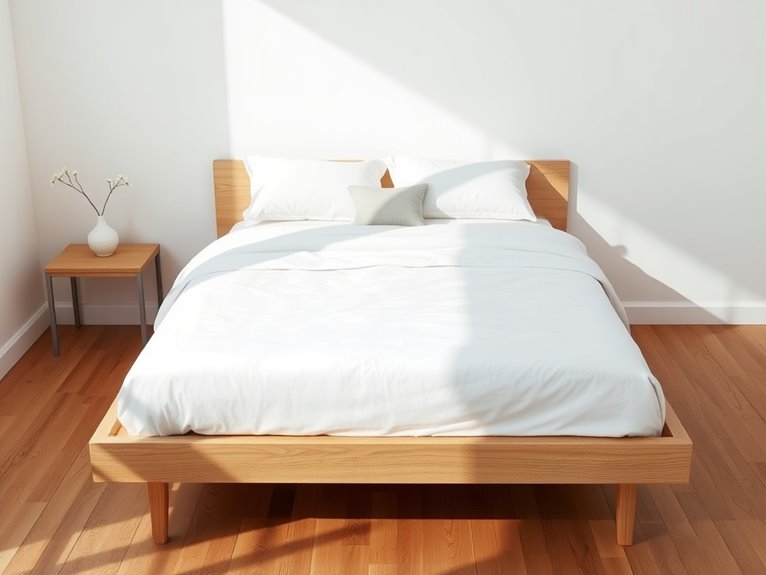
A minimalist platform bed with clean lines creates a serene, uncluttered focal point that exemplifies modern simplicity. The understated design, characterized by straight edges and a low profile, allows the bed to ground the space without overwhelming it, making the room feel more spacious and organized.
This streamlined approach to bed styling strips away unnecessary elements, letting the bed’s architectural form speak for itself. This styling technique works particularly well in contemporary, Scandinavian, or Japanese-inspired interiors where simplicity reigns supreme. It’s an evergreen approach that transcends seasonal changes, though it can be subtly modified throughout the year with textile variations.
The style is especially effective in smaller bedrooms where visual clutter needs to be minimized, or in rooms where other architectural elements deserve attention.
Essential Components:
- Platform bed frame (preferably in natural wood or neutral finish)
- High-quality fitted sheet
- Flat sheet
- Minimalist duvet cover
- Two standard pillows
- Two pillowcases
- Light cotton blanket
- Simple throw pillow
- Bed risers (optional)
- Level tool
How to Achieve This Look
Begin with a well-constructed platform bed positioned away from walls to create breathing space. Center the bed on the main wall, ensuring it’s perfectly level to maintain clean lines.
Install the fitted sheet with military precision, pulling corners taut to eliminate wrinkles and create crisp edges. Layer the flat sheet and duvet with intentional simplicity, focusing on straight lines and equal overhang on both sides.
Fold the top portion of the sheet over the duvet edge, creating a clean border approximately 6 inches wide. This detail adds visual interest while maintaining minimalist principles.
Select a color palette dominated by neutrals – whites, grays, or earth tones – with perhaps one accent color introduced through a single throw pillow or blanket. Natural materials like linen and cotton in solid colors work best, avoiding patterns that could disrupt the clean aesthetic.
When photographing the style, capture straight-on angles to emphasize the geometric nature of the design.
Pro Styling Tips
Create a daily bed-making ritual that maintains the clean lines: start with smoothing the fitted sheet while still slightly damp from washing for fewer wrinkles, use a ruler to ensure duvet sides hang exactly equal distances, and keep spare bedding in the same color family for easy switches.
For smaller rooms, choose a platform bed with built-in storage to maintain the minimalist aesthetic while maximizing functionality. In winter, add warmth through texture rather than quantity – think cashmere throws or brushed cotton sheets rather than multiple blankets that could create bulk.
Low-Profile Floor Bed Frame
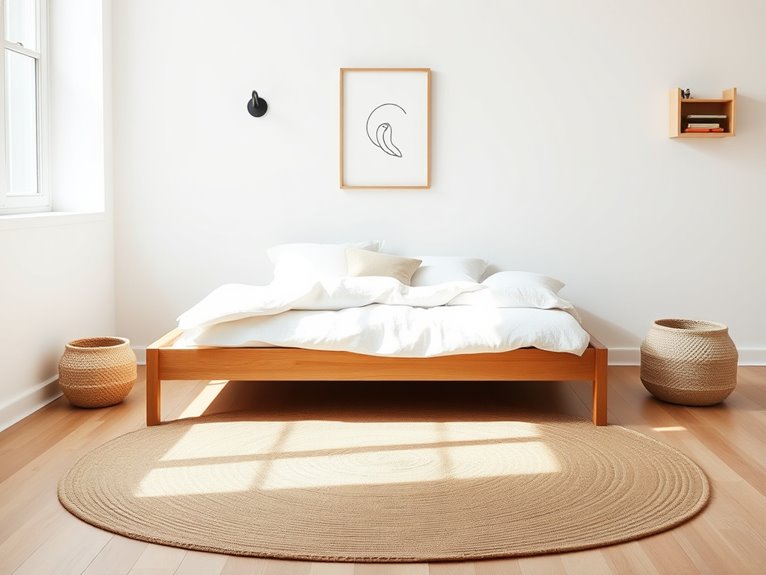
A low-profile floor bed frame embodies the essence of modern minimalist design while creating an airy, open feeling in any child’s bedroom. The understated elegance of a bed positioned close to the ground instantly makes the ceiling appear higher and establishes a serene, uncluttered atmosphere that promotes better sleep and calm energy.
This styling technique works particularly well in contemporary spaces, Montessori-inspired rooms, and smaller bedrooms where visual space matters. The low-profile design proves ideal year-round but especially shines in summer months when a lighter, breezier aesthetic is desired. It’s also perfect for young children transitioning from cribs, as the minimal height eliminates safety concerns while fostering independence.
Essential Components:
- Low-profile wooden or metal bed frame (6-12 inches height)
- Firm mattress
- Fitted sheet
- Flat sheet
- Light duvet or coverlet
- 2-4 sleeping pillows
- Small accent pillows
- Natural fiber rug
- Wall-mounted reading light
- Storage baskets
- Simple artwork
How to Achieve This Look
Begin by positioning the bed frame against a clean wall, ensuring equal space on both sides for balance.
Select bedding in neutral tones like warm white, oatmeal, or soft gray to maintain the minimalist aesthetic. Layer the bed starting with a high-quality fitted sheet, followed by a flat sheet tucked in with precise hospital corners.
Add visual interest through texture rather than pattern – consider a linen duvet cover or cotton waffle-weave blanket folded at the foot of the bed. Place two standard pillows at the headboard, dressed in coordinating pillowcases, and add one or two small decorative cushions in complementary natural materials.
Complete the look by incorporating subtle dimensional elements around the bed frame. Position a natural fiber rug underneath, extending at least 24 inches on three sides. Install a sleek wall-mounted reading light and hang simple, monochromatic artwork at child-height level. Keep the surrounding floor space clear, using only small storage baskets if necessary.
Pro Styling Tips
For a designer-worthy appearance, maintain strict color discipline by limiting the palette to three neutral shades maximum.
Scale decor elements proportionally to the low height – artwork should start at the child’s eye level and extend no more than 24 inches above the bed.
Rotate textural elements seasonally: chunky knits and warm textures for winter, lightweight linens and cotton for summer. To preserve the minimalist aesthetic with daily use, establish a simple morning routine of straightening the duvet and fluffing pillows, storing extra items in designated baskets to prevent visual clutter.
Scandinavian-Style House Bed
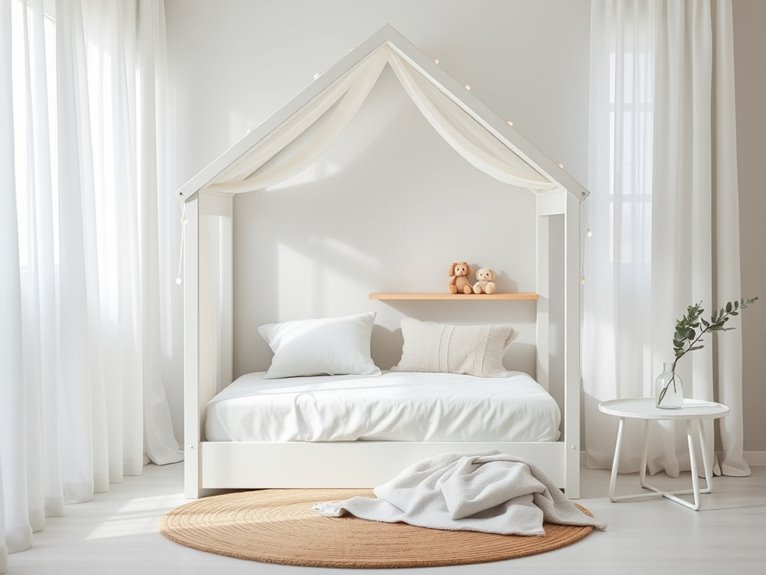
The Scandinavian-style house bed embodies the perfect blend of whimsy and minimalist design, featuring clean lines and a distinctive house-shaped frame that creates an architectural focal point in any child’s room. This signature Nordic design transforms a basic sleeping space into a cozy sanctuary while maintaining the understated elegance that Scandinavian design is renowned for, typically crafted from natural wood or painted in crisp white.
This versatile bed style works particularly well in modern minimalist homes and adapts beautifully across all seasons, though it truly shines in creating a warm, hygge atmosphere during colder months. The house frame structure offers endless styling possibilities, from bare simplicity to decorated seasonal charm, making it an ideal choice for children’s rooms that grow and evolve with their occupants.
Essential Components:
- House-frame bed structure
- Cotton or linen duvet cover in neutral tones
- Natural fiber sheets
- Minimalist pillowcases
- Small accent cushions
- Cotton canopy or draped fabric (optional)
- LED string lights
- Natural fiber rug
- Wall hooks or clips
- Simple wooden toys for decoration
- Neutral throw blanket
How to Achieve This Look
Begin by positioning the house bed against a neutral wall, preferably in white or light gray, to create a clean backdrop that enhances the bed’s architectural appeal. Center the bed frame to allow equal space on both sides, ensuring the room maintains its balanced composition and allows for easy access.
Layer the bedding starting with crisp white or oatmeal-colored sheets, followed by a minimalist duvet cover in soft, muted tones like pale gray, dusty rose, or sage green. Add texture through carefully chosen pillows, limiting the selection to two sleeping pillows and no more than three decorative cushions in complementary neutral shades.
For authenticity in Scandinavian style, incorporate natural elements through wooden accessories and simple textile choices. String delicate LED lights along the house frame’s upper beams, creating a gentle glow that emphasizes the bed’s architectural outline.
Consider adding a light, gauzy canopy in white or cream to soften the geometric lines while maintaining the airy aesthetic.
Pro Styling Tips
Create visual interest by alternating textures rather than colors – combine chunky knits with smooth linens and soft cotton, all within the same neutral color family. For seasonal adaptations, swap textiles rather than adding decorative elements: lighter linens for summer, wool and chunky knits for winter.
Keep the bed’s surroundings clutter-free by implementing simple storage solutions, and maintain the minimalist appeal by rotating decorative elements rather than displaying them all at once. A designer secret is to photograph the setup during morning hours when natural light creates soft shadows that highlight the bed frame’s architectural details.
Essential Space-Saving Loft Bed
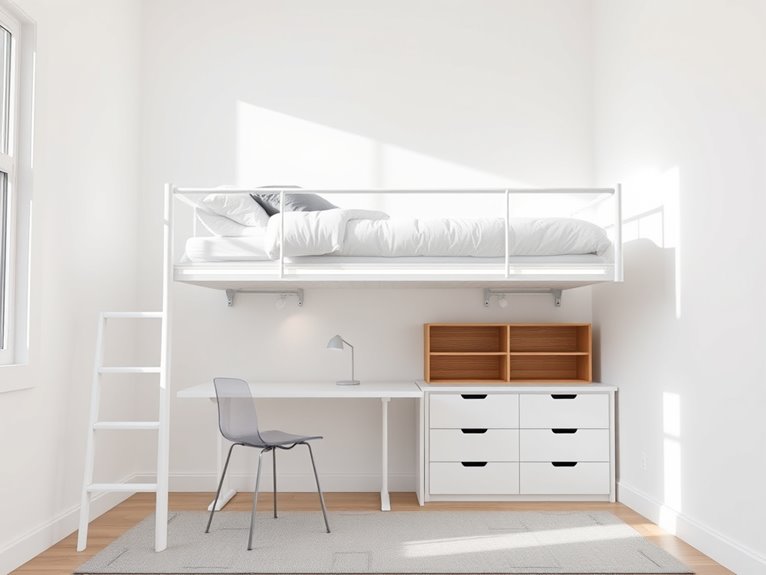
A well-designed loft bed transforms a child’s room into a multi-functional space while maintaining clean, minimalist aesthetics. The elevated sleeping area creates an architectural focal point, featuring sleek lines and uncluttered surfaces that epitomize modern design principles. The visual impact comes from the bed’s geometric structure, typically in neutral tones like white, natural wood, or matte black, which allows the space beneath to remain open and airy.
This space-saving solution works particularly well in compact urban homes or shared bedrooms where floor space is premium. The style adapts seamlessly to any season and complements contemporary, Scandinavian, or industrial interior designs. Most effective in rooms with ceiling heights of 8 feet or greater, this arrangement provides the perfect foundation for creating distinct zones for sleeping, studying, and playing while maintaining a clutter-free environment.
Essential Components:
- Loft bed frame with integrated ladder
- Twin-size mattress
- Cotton fitted sheet
- Lightweight duvet
- 2-3 minimal throw pillows
- Safety rail covers
- Under-bed LED lighting
- Desk or play area furniture
- Storage containers
- Non-slip rug
- Wall-mounted shelving
- Cable management solutions
How to Achieve This Look
Start by positioning the loft bed against a wall, ensuring adequate clearance for ceiling lights and proper ventilation. Install the bed frame following manufacturer guidelines, paying special attention to securing all support points.
Add integrated storage solutions like wall-mounted shelves or hooks during this initial setup phase to maintain the minimalist aesthetic.
The bedding selection plays a crucial role in achieving the minimalist look. Choose solid-colored sheets and duvet covers in neutral tones like white, gray, or soft beige. Layer with no more than two accent pillows in complementary colors. For visual interest, incorporate subtle texture variations rather than bold patterns.
Create a functional space below by establishing clear zones. A study area might include a floating desk and ergonomic chair, while a play space could feature low storage cubes and a comfortable floor cushion.
Maintain color consistency between upper and lower zones, using a palette of 2-3 colors maximum. For photography, capture the entire vertical space to showcase the bed’s architectural qualities and smart space utilization.
Pro Styling Tips:
To maintain the minimalist aesthetic while maximizing functionality, use hidden storage solutions like under-desk drawers or bed-frame integrated compartments.
Adapt the style seasonally by switching accent pillow covers or adding a lightweight throw in summer months. For daily maintenance, implement a “one in, one out” rule for visible items and teach children to make their bed immediately after waking – the elevated position makes an unmade bed particularly noticeable in the room’s overall composition.
Consider installing a retractable desk or fold-down table to create even more floor space when needed.
Modern Trundle Bed Design
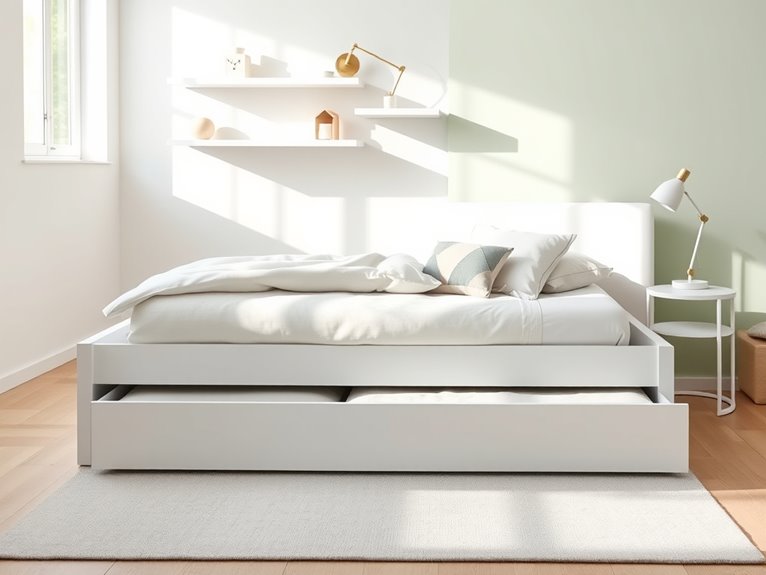
Clean lines and space-saving functionality define the modern trundle bed aesthetic, combining minimalist design principles with practical solutions for growing families or frequent guests. The beauty of contemporary trundle beds lies in their dual-purpose nature – a sleek primary bed that conceals a secondary sleeping space beneath, all while maintaining a sophisticated and uncluttered appearance that appeals to both children and design-conscious parents.
This styling technique works particularly well in urban homes where space optimization is crucial, and in rooms that embrace contemporary or Scandinavian design elements. The modern trundle bed design is versatile enough to transition through all seasons, though it especially shines in smaller bedrooms where maintaining visual breathing room is essential. The style’s adaptability makes it perfect for children’s rooms that need to grow with their occupants or guest rooms that require flexible sleeping arrangements.
Essential Components:
- Platform bed frame with trundle mechanism
- Two matching mattresses (main and trundle)
- Fitted sheets in coordinating solid colors
- Duvet cover in neutral or monochromatic tones
- Minimal throw pillows (2-3 maximum)
- Low-profile storage containers
- Simple bedside lamp
- Geometric area rug
- Wall-mounted storage solutions
- Cable management accessories
How to Achieve This Look
Begin by positioning the trundle bed against the longest wall, ensuring smooth operation of the pull-out mechanism. Select bedding in a monochromatic color scheme, focusing on whites, grays, or muted earth tones to maintain the minimalist aesthetic. Layer the main bed with a fitted sheet, followed by a crisp duvet cover that falls just above the floor level when the trundle is concealed.
Address the functional aspects by installing wall-mounted storage and lighting solutions that don’t compete with the bed’s clean lines. Choose bedside accessories that serve a purpose while maintaining visual simplicity – think slim-profile reading lamps and floating shelves rather than traditional nightstands.
Keep the trundle bedding coordinated but slightly distinct from the main bed to create visual interest when both beds are in use. Select accent colors that complement without overwhelming – soft blues, pale pinks, or gentle greens can add personality while maintaining the modern aesthetic. When styling for photos, capture angles that showcase both the bed’s sleek design and its clever functionality, demonstrating how the trundle smoothly transitions from hidden to revealed states.
Pro Styling Tips:
For maximum versatility and continued aesthetic appeal, invest in high-quality, wrinkle-resistant bedding in timeless colors. Scale the styling elements according to room size – smaller spaces benefit from lighter colors and fewer accessories, while larger rooms can accommodate bolder geometric patterns or contrasting color blocks.
To maintain the clean look with daily use, implement a simple morning routine of tucking and smoothing bedding, and consider using bed lifters on the main frame to ensure effortless trundle operation while preserving the streamlined appearance.
Basic Wood Frame With Storage
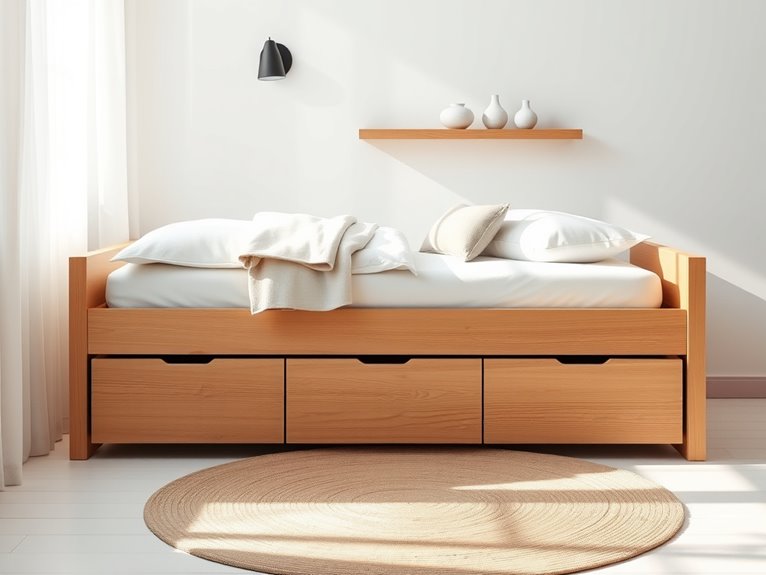
A basic wood frame bed with integrated storage represents the perfect marriage of form and function in children’s bedroom design. The clean lines and natural wood tones create a serene foundation that allows other design elements to shine while maintaining visual harmony.
Whether left in its natural state or painted in subtle neutrals, the straightforward design of a basic wood frame promotes a calm sleeping environment while offering practical storage solutions. This versatile bed style works particularly well in contemporary, Scandinavian, or modern farmhouse bedroom designs, adapting seamlessly to any season through simple bedding changes.
The built-in storage compartments eliminate the need for additional furniture pieces, making it ideal for smaller rooms or shared spaces. The timeless appeal of natural wood ensures longevity as your child’s tastes evolve, while the minimalist design prevents visual clutter that can interfere with rest.
Essential Components:
- Solid wood bed frame with storage drawers
- Cotton mattress protector
- Fitted sheet
- Flat sheet
- Duvet or comforter
- 2-4 pillows with cases
- Storage bins or organizers
- LED reading light
- Natural fiber rug
- Simple curtains or blinds
- Basic tool kit for assembly
How to Achieve This Look:
Start with the bed frame position, ideally against a wall but with enough clearance on both sides to access storage drawers. Choose bedding in solid colors or simple patterns that complement the wood tone – whites, grays, and soft earth tones work exceptionally well.
Layer the bed starting with a high-quality mattress protector, followed by crisp fitted and flat sheets. Create visual interest through texture rather than pattern by selecting bedding materials in different weights and weaves. A lightweight cotton duvet for summer can be swapped with a chunky knit blanket for winter, while maintaining the minimalist aesthetic.
Keep pillows simple with no more than two sleeping pillows and perhaps one accent pillow in a complementary texture. Organize the storage drawers using fabric bins or dividers in neutral tones that match the overall color scheme. This maintains the clean look even when drawers are opened.
For photography purposes, ensure natural light falls across the bed to highlight the wood grain and bedding textures, creating depth without compromising the minimalist approach.
Pro Styling Tips:
To maximize the minimalist appeal while maintaining functionality, use bedding in a monochromatic color scheme two shades lighter or darker than the wood frame. Adapt the look seasonally by switching out single elements like throw pillows or blankets rather than complete bedding sets.
For daily maintenance, implement a simple morning routine of smooth pulls on sheets and duvet, keeping stored items organized in designated drawer sections to prevent overflow and maintain the clean aesthetic.
Neutral Daybed With Sleek Rails
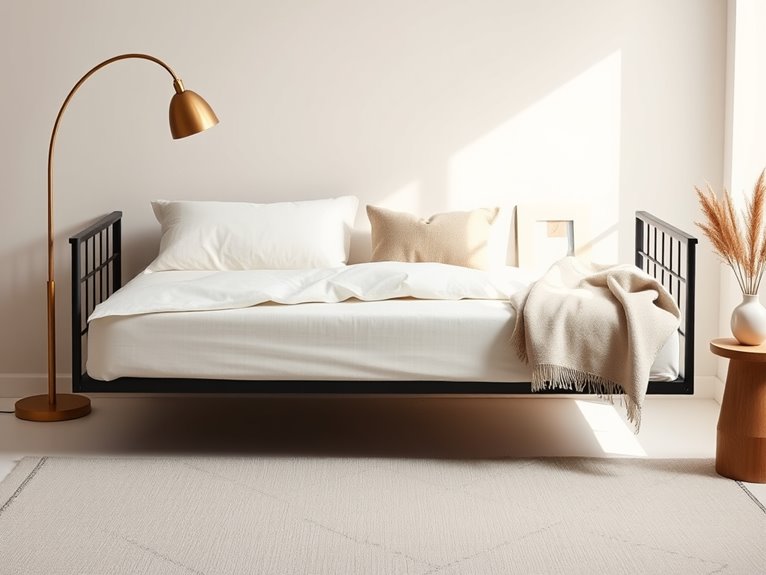
A neutral daybed with sleek rails embodies modern minimalism while maintaining a welcoming, versatile aesthetic. The clean lines of slim metal or wooden rails paired with neutral-toned bedding creates a sophisticated yet approachable focal point that works equally well in a child’s bedroom, guest room, or multi-purpose space. The understated design allows the bed to seamlessly integrate with various décor styles while providing both seating and sleeping functionality.
This styling technique proves particularly effective in smaller spaces where versatility is key and works year-round with simple textile adjustments. The neutral palette serves as a perfect canvas for seasonal accessories while the sleek rails maintain visual lightness that prevents the piece from overwhelming the room. This approach is especially suitable for modern, Scandinavian, or transitional interior styles where form meets function in a refined way.
Essential Components:
- Daybed frame with minimal rails
- Firm mattress or cushion
- Neutral fitted sheet
- Cotton or linen duvet cover
- 2-3 standard pillows
- 2-4 decorative throw pillows
- Light throw blanket
- Mattress protector
- Non-slip rug pad (if placing on hard floors)
- Level for installation
How to Achieve This Look
Begin by positioning the daybed against a wall or in a corner where it can serve as both seating and sleeping space. Ensure the frame is perfectly level and stable, as this affects both the aesthetic and functionality.
Layer the bed starting with a high-quality mattress protector, followed by crisp, neutral-colored fitted sheets in white, cream, or light gray. Select a duvet cover in a complementary neutral shade, avoiding patterns to maintain the minimalist aesthetic. The duvet should be neatly tucked on three sides when used as a daybed, with the front edge folded down precisely. For added dimension, choose materials with subtle texture variations, such as linen or stonewashed cotton.
Arrange pillows strategically, starting with two standard pillows in crisp white cases at the back, positioned vertically against the wall. Add decorative pillows in coordinating neutral tones, varying in size and texture but maintaining a cohesive color story. Consider soft grays, warm beiges, and muted earth tones for a sophisticated palette that remains child-friendly.
Pro Styling Tips
For maximum versatility, invest in two sets of decorative pillows – one in cool tones and one in warm tones – to easily transition between seasons without changing the entire bed setup. In smaller rooms, opt for a daybed with under-bed storage drawers to maintain the minimalist aesthetic while maximizing functionality.
Keep the look fresh by implementing a weekly rotation of pillows and bedding to prevent wear patterns, and consider using a removable slipcover for the mattress to protect against daily use while maintaining the clean aesthetic.
Convertible Toddler-to-Twin Bed
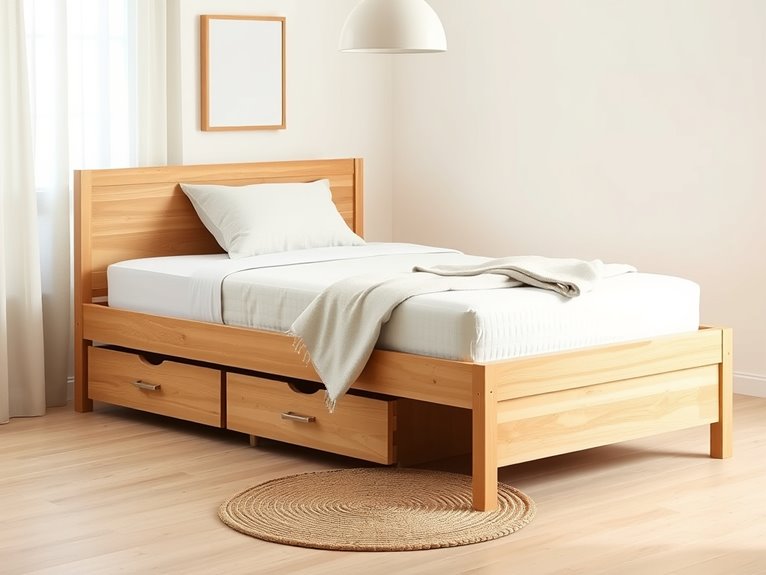
A convertible toddler-to-twin bed embodies the perfect balance of practicality and clean design aesthetics. The streamlined silhouette typically features smooth lines and adaptable components that grow with your child, while maintaining a clutter-free appearance that’s essential to minimalist design.
Natural materials and neutral colors create a calm, organized space that appeals to both parents and children, making the transition between bed sizes seamless and stylish. This versatile bed style works particularly well in modern or Scandinavian-inspired children’s rooms, offering longevity and adaptability as your child grows.
The minimalist approach allows for easy seasonal updates through simple bedding changes, while the convertible feature provides excellent value for money. Best implemented in rooms with neutral wall colors, this style can be maintained year-round and pairs beautifully with both natural light and warm artificial lighting.
Essential Components:
- Convertible bed frame with conversion kit
- Twin-size mattress
- Waterproof mattress protector
- Cotton fitted sheet
- Flat sheet
- Lightweight duvet or quilt
- Duvet cover in neutral tone
- 2-4 pillows
- Simple pillowcases
- Under-bed storage containers
- Safety rail (for toddler configuration)
- Allen wrench set
- Screwdriver set
How to Achieve This Look
Begin by selecting a convertible bed frame in white, natural wood, or light gray to establish a clean foundation. These neutral colors create versatility and longevity in the design while maintaining the minimalist aesthetic.
Ensure the frame has smooth edges and simple lines without ornate details or unnecessary embellishments. Layer the bed with high-quality, solid-colored bedding in soft, muted tones such as ivory, pale gray, or soft beige. Start with a fitted sheet, add a flat sheet, and top with a lightweight duvet in a simple cover.
Avoid busy patterns or multiple colors to maintain the minimalist appeal. The bedding should lie flat and neat, with crisp corners and minimal wrinkles. Focus on the functionality of the conversion features while styling.
Install under-bed storage solutions that blend seamlessly with the frame, using neutral-colored containers or baskets. Keep the space around the bed clear and uncluttered, allowing the convertible design to be the focal point. When photographing, capture the bed from multiple angles to showcase both its current configuration and conversion potential.
Pro Styling Tips
Make the most of the convertible design by selecting modular storage pieces that can adapt alongside the bed size changes. For seasonal updates, swap out single accent pieces like a throw pillow or small blanket rather than changing the entire bedding set.
Keep conversion hardware organized in labeled containers, and maintain the minimalist look by teaching children to make their bed daily with simple, straight folds rather than complicated tucking methods. When transitioning between sizes, take the opportunity to edit and declutter accompanying bedroom items to maintain the clean aesthetic.
